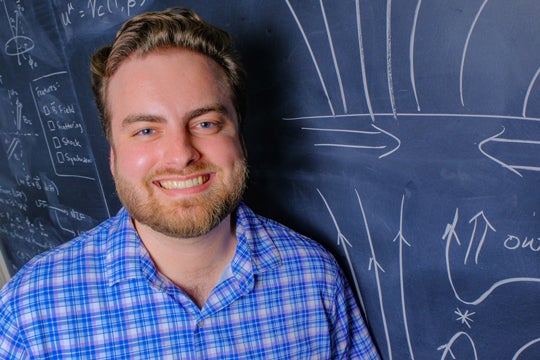Rice graduate students Aindrila Pal and Gregory Szypko have won NASA Future Investigators in NASA Earth and Space Science and Technology (FINESST) awards, which include merit-based grants designed to prepare future leaders in the field.
FINESST is one of the largest funding programs for U.S.-based graduate students in Earth and space sciences. It is highly competitive with NASA funding only about 15% of proposals received each year.
Pal, a third-year Ph.D. student in Earth, environmental and planetary sciences, will conduct her research under the mentorship of Professor Rajdeep Dasgupta. The FINESST grant will allow her to explore one of the most fundamental questions in planetary science: How did Earth develop and maintain a state suitable for harboring life?

Pal said Earth’s habitability is strongly linked to the unique way that life-essential volatile elements like oxygen, hydrogen, carbon and nitrogen are distributed throughout the planet.
“This project focuses on understanding the origin and evolution of nitrogen across space and time, particularly in rocky planetary bodies,” Pal said. “The study will use a combination of computational models and high-pressure, high-temperature experimental simulations of early planetary processes to predict nitrogen’s origin and abundance in Earth’s early atmosphere as well as in other rocky bodies of the inner solar system like Mars, the moon, Mercury, Venus and the parent bodies of meteorites.”
Pal said the research will be extremely useful as scientists look for habitable and inhabited planets around distant stars. NASA’s James Webb Space Telescope, for example, is poised to deliver the most detailed observational data yet on exoplanet atmospheres, and Pal’s research will be useful for interpreting the data and determining exoplanetary nitrogen budgets.
Szypko is a fourth-year physics Ph.D. student researching the dynamics of the sun’s outer atmosphere to better understand phenomena such as the solar wind, solar flares and coronal mass ejections.
“The sun continuously sends out a wind of hot particles in all directions that collides with Earth and everything else in the solar system,” said Szypko, whose doctoral work is overseen by Professor Stephen Bradshaw. “Some of this solar wind is flung outward by the changing shape of magnetic loops in the sun’s atmosphere in a process called interchange reconnection.”

Szypko illustrated interchange reconnection by comparing it to a “simple beaded necklace.”
“Imagine a closed loop of string threading several beads,” he said. “If I take the necklace in my hand and swing it around, the beads might slide back and forth, but they’ll stay on the necklace since the loop is closed. However, if I take a pair of scissors and cut the string as I swing the necklace around, the beads will fly off of the string.
“Cutting that string is a bit like interchange reconnection: The string is the magnetic field, and the beads are the charged particles making up the sun’s atmosphere. These charged particles can only move back and forth along the length of the magnetic field, meaning a closed magnetic field loop traps the particles in the atmosphere. But when interchange reconnection occurs, the closed loop is suddenly opened up, freeing the particles to flow away from the sun.”
By simulating the behavior of different kinds of particles — chemical elements and charge states — during interchange reconnection, Szypko hopes to understand “the fingerprints” this process leaves in the solar wind it generates.
“The solar wind bathes everything in our solar system, so the better we can understand and predict patterns in its formation, the more confident we can be in sending missions and instruments up into space,” he said.
The sun’s activity can affect the Earth in more dramatic ways, too.
“In more extreme cases, similar processes in the sun’s atmosphere can lead to geomagnetic storms,” Szypko said. “These disturbances of Earth’s magnetic field can interfere with and damage all kinds of electrical equipment from power lines to GPS satellites.”
Given that the sun is the star nearest to us, it is also the best resource we have for studying stars across the galaxy.
“An important consideration in determining whether a distant planet could support alien life is the strength of its host star’s wind,” Szypko said. “A more detailed understanding of our own sun’s wind will therefore help us infer how suitable these distant planets could be for supporting life.
“I’m honored to have been selected as a recipient and truly grateful to the NASA Science Mission Directorate for deciding to fund my work. Receiving the award has been a strong incentive to make sure my research is the best it can be — I feel a duty to live up to the high bar of expectations set by the award.”
Bradshaw is a professor of physics and astronomy. Dasgupta is the Maurice Ewing Professor of Earth, Environmental and Planetary Sciences.

